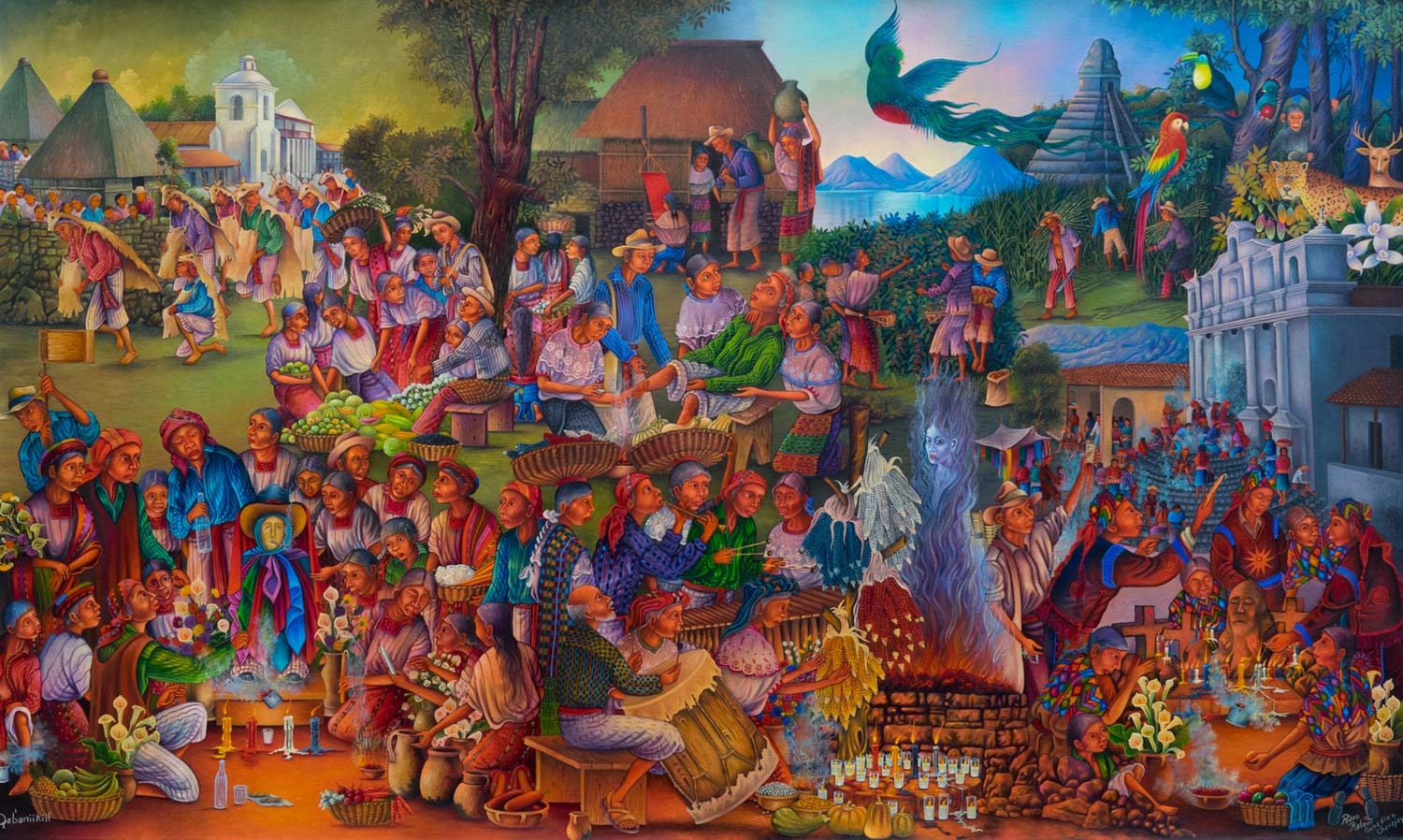In this painting, Pedro Rafael Gonzalez Chavajay depicts some of the Maya spiritual traditions and practices in three towns. Tz’utujil-speaking Santiago Atitlan is depicted on the left; Tz’utujil-speaking San Pedro, where Pedro Rafael lives, is in the center; and Kiche-speaking Chichicastenango is on the right. In the right corner of the painting is the representation of the forest and the animals that surround the temple of Tikal in the city of Mutul.
In the upper left of the painting, in front of the church in Santiago Atitlan, we see the performance of the Deer Dance, one of the oldest of the masked dances of Guatemala with roots in pre-Hispanic Maya traditions. In the lower left-hand corner, we see people honoring the Ri’jlaj Mam, more commonly known as Ma’ Ximoon (Maximón), a deity connected with the Maya creation story, and a symbol for those preserving pre-Hispanic ways. In between the Deer Dance and Maximón, Pedro Rafael has painted a market scene in Santiago Atitlan. For centuries, Santiago Atitlan has been on the trade route between the mountainous highlands of Guatemala and the Pacific Coast. Its market has an abundance of products from both areas.
San Pedro la Laguna is famous throughout Guatemala for its Maya bonesetters. In the center of the painting, we see a man in a green shirt who is having a fracture set by a bonesetter (curandero de hueso). Bonesetting is one of the Maya spiritual professions for both men and women. People are called through their dreams to the practice, for which they cannot charge money.
The bottom center depicts the ritual blessing of the corn with music from the marimba and tambor (drum). Candles and incense are at an altar, above which we see an apparition of the spirit of corn (ruuk’u’x ixim). At the top we see a weaver and a water carrier performing the traditional work of all Maya communities, including San Pedro.
In the lower right corner of the painting, we see ajq’ijab’ (Maya day-keepers) performing a ritual at the rock called Pascual Ab’aj in Chichicastanenango. Pascual Ab’aj is the most famous ritual site, out of many hundreds of sites throughout Guatemala, where Maya people have performed ceremonies for hundreds of years. Above the depiction of Pascual Ab’aj, we see the church of Santo Tomas where other ajq’ijab’ perform ceremonies daily. The steps of the church are built from the stones of a pre-Hispanic altar on the site.
In the upper right-hand corner, we see other symbols that are important to the Maya and for all Guatemalans: the pyramid at Tikal; the endangered quetzal bird; Lake Atitlan; and the monja blanca (white nun), an orchid that is the national flower of Guatemala. We also see the jaguar, deer, and monkey—animals that are all important to the Maya and connected to the days of the Maya calendar. Pedro Rafael has also included a parrot and a macaw along with people working in the fields harvesting coffee and sugar cane.
In this one painting, Pedro Rafael Gonzalez Chavajay has represented much of the variety and richness of Maya spiritual traditions, each of which merits a book of its own.


